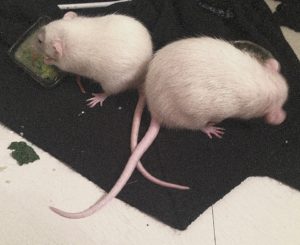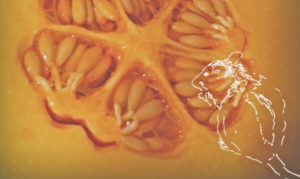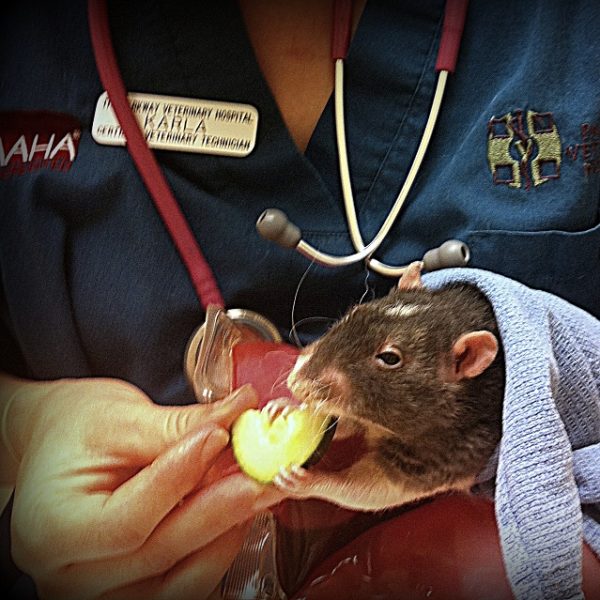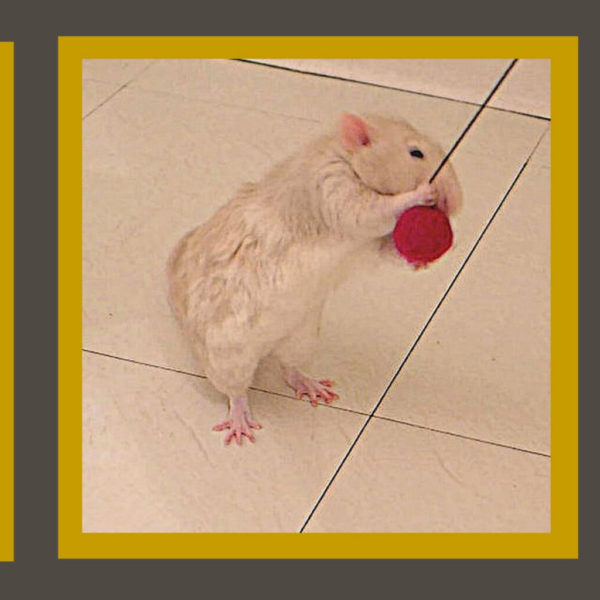Overheating is a matter of life and death: Rats don’t have sweat glands. Since they can’t sweat, excessive heat is dissipated through their tails. Some believe that rats born in hotter months have longer tails. Their longer tails give them more tail surface to release the extra heat.

It’s no surprise that wild rats are nocturnal—being awake and active at night helps them avoid the daytime heat.
How can you tell if your rat is overheated?
Besides by simply feeling your rat’s body temperature with your hands, you’ll see that your rat has turned into a “pancake” when it’s too hot. By “pancake,” I mean they literally flatten themselves out. Like cats and dogs, your rat will stretch out and lie as elongated as possible on top of cooler surfaces rather than inside any boxes, hanging beds or other hideouts. When hot, their tail will also be hot to the touch.
If your rat appears to be more than just moderately warm, you’ll also notice drooling, heavy/open-mouthed breathing and extreme lethargy. If this is what you’re seeing, continue reading to learn what to do in the event of heatstroke.
Signs of pet rat heatstroke
-
- Drooling
- Open-mouthed breathing
- Lethargy, weakness, reluctance to move, limp body
- Lying flat like a pancake
What to do if your rat experiences heatstroke:
It’s important to cool off your rat GRADUALLY to prevent further complications. If cooled off rapidly and excessively, life-threatening damage can result.
How to safely cool your rat
Do this quickly because you’ll also want to get your rat to the vet as soon as possible.
Remove your rat from the heated environment immediately. Handle her as gently as possible. Begin cooling your rat slowly by sprinkling water over her fur. (The water should be at a moderate temperature— in between hot or cold.) You can also drizzle water onto your rat’s ears, hands, feet and tail.
Call ahead and prepare to take your rat to your vet
Phone your vet to let them know you’re on your way and that your rat may have suffered from heat stroke. The reason it’s good to call first is it gives your veterinarian advance notice so they can quickly work you into their schedule the moment you arrive. Your call also helps allow the technicians time to prepare essential supplies and equipment.
This is yet another example of why you want to already have a well-established relationship with a vet for your rats. If your rat is already a patient at your vet’s office, they’ll be especially prepared to help your rat as soon as it arrives. They’ll already have your rat registered in their system and will already be familiar with your rat’s history (including your rat’s age).
Place your rat inside a small carrier to transport her to the vet. Line the inside of the carrier with a wet towel. As explained above, make sure the water used to wet the towel is neither too hot nor too cold.
Since you’ve phoned ahead, when you enter your veterinary clinic, a technician, assistant or receptionist will be ready to immediately take your rat to the treatment area. Usually, fluids and possibly oxygen will be administered. They’ll have these all set up in anticipation of your rat’s arrival.
Your veterinarian will want to keep your rat under observation for at least an hour in case further signs of damage appear and to make sure your rat recovers as fully as possible. Internal organs can be damaged, and some symptoms may not appear right away. Once you bring your rat home, you’ll want to monitor closely and report any changes and concerns to your vet immediately.
How can I prevent pet rat heatstroke?
-
- Close windows, drapes and blinds during the day
- Freeze water in plastic containers. These can be water bottles anywhere in size from 16 oz on up to a gallon. You can also freeze water in any type of plastic or glass food containers. If using glass, remove the lid while freezing. Put the lid back on before placing the frozen water in your rats’ cage. Position the frozen water in their cage so your rat can choose to lie next to or on top of the icy containers. Have two sets of frozen water containers prepared. This way, once one set of frozen water containers melts, you’ll already have a second set of completely frozen ones in the freezer. Replace the containers in the cage once the water becomes warm and is melting.
- Offer your rats cooling treats such as frozen peas, strawberries, watermelon and cantaloup

Offer your rats cooling treats such as frozen peas, watermelon and cantaloupe. e. A fun game is “pea diving” which combines a frozen treat with water: Fill a glass casserole dish with about an inch of water. Place frozen peas in the water and let your rats begin “diving” for peas.
- Sprinkle or mist your pet rats with water. (Water should be a normal room’s temperature, neither excessively hot nor cold.)
- Use a fan to keep the air circulating. If they’ve been sprinkled or spritzed with water, the fan will cool your rats. (Otherwise, the fan will just be blowing warm air on them.)
- If the room temperature is over 80 degrees and/or if your rats appear uncomfortable, they need to be moved to a cooler spot. If their regular cage is too large to move, a smaller cage or a carrier can be placed on the floor of the coolest room in your house or apartment.
- If there isn’t a cooler spot for your rats at home, take them over to stay in a friend’s house that’s air conditioned.
- Never, ever leave your rats inside a parked car in the summer. Even if you park in the shade, temperatures can still escalate quickly inside your car. This is true even if you’ve cracked the windows. If you need to take your rats with you while you’re out running errands, use a shoulder bag and take them inside with you rather than leaving them in the car. (On the Road with Rats gives further information on using a shoulder bag.)information on using a shoulder bag.)
In Conclusion
Hopefully, you’ll be able to prevent pet rat heatstroke by using the above tips for keeping your pet rats cool. However, if you do end up needing to take an overheated rat to the vet, you’ll know to call ahead, how to transport your rat and what to expect when you get there.
updated 7/30/24









my rat died over the summer too, could it have been my mom dropping her cage?
I’m so sorry to hear your rat died. You asked if her death could’ve been caused by your mother dropping her cage. I’m guessing that your rat was in the cage when it was dropped? If so, the traumatic impact could have injured your rat. It’s difficult to say, though, without knowing what was inside her cage and how it was set up. There’s a chance, if there was lots of soft bedding to cushion her, it may not have injured her. I always advise taking a rat to a veterinarian who’s knowledgeable about and experienced with pet rats anytime there’s a traumatic event or even just for wellness checkups. My thoughts are with you. I know how difficult it is to lose a rat.
—-Jasmine
I’m so sad I think my
rat died from heat stroke .
Oh, Emily. I’m so sorry to hear your rat has died and you think it was due to being overheated. Dying from excessive heat can happen so easily for our pet rats. I know you didn’t intentionally cause your rat’s death. I also know how terrible you must feel knowing you could have prevented it. It’s good that you’re looking up information and learning how to do things differently in the future. Meanwhile, my heart goes out to you. I really do feel for you and am thinking about you. Sending many caring and comforting thoughts for you. —Jasmine
yeah i get you i lost a rat and i’m scared we’re going to loose another she has a lump on her neck, my mom thinks that it is cancer or a tumor. either way she might die from it, any advice that will make the end of her life the best part?
Zoeita,
A rat with a lump on her neck can be helped by a veterinarian who’s knowledgeable about and experienced with pet rats. Here’s my page on Pet Rat Tumors. Most tumors can be surgically removed and your rat can easily recover and live a normal, healthy life. It’s very common for female rats to get tumors. One way to help prevent tumors is by getting female rats spayed.
I do hope you’ll be able to take your rat to a vet who will be able to remove the tumor.
Let me know if you have any additional questions anytime.
Best Wishes to You & Your Rat,
Jasmine | About Pet Rats
Very useful info and facts I didn’t know (releasing heat through the tail skin). The frozen water bottles is a great idea, I used to do this for my rabbits in the summer too. Thank you!
Hi Tonia Marie,
Thanks so much for letting me know you found this information helpful!
I hope you and your rats are staying at a comfortable temperature this summer.
Jasmine | About Pet Rats